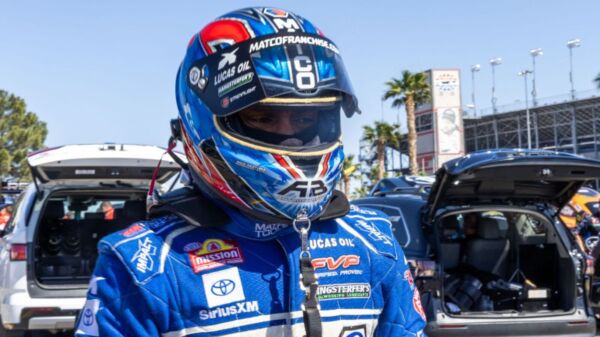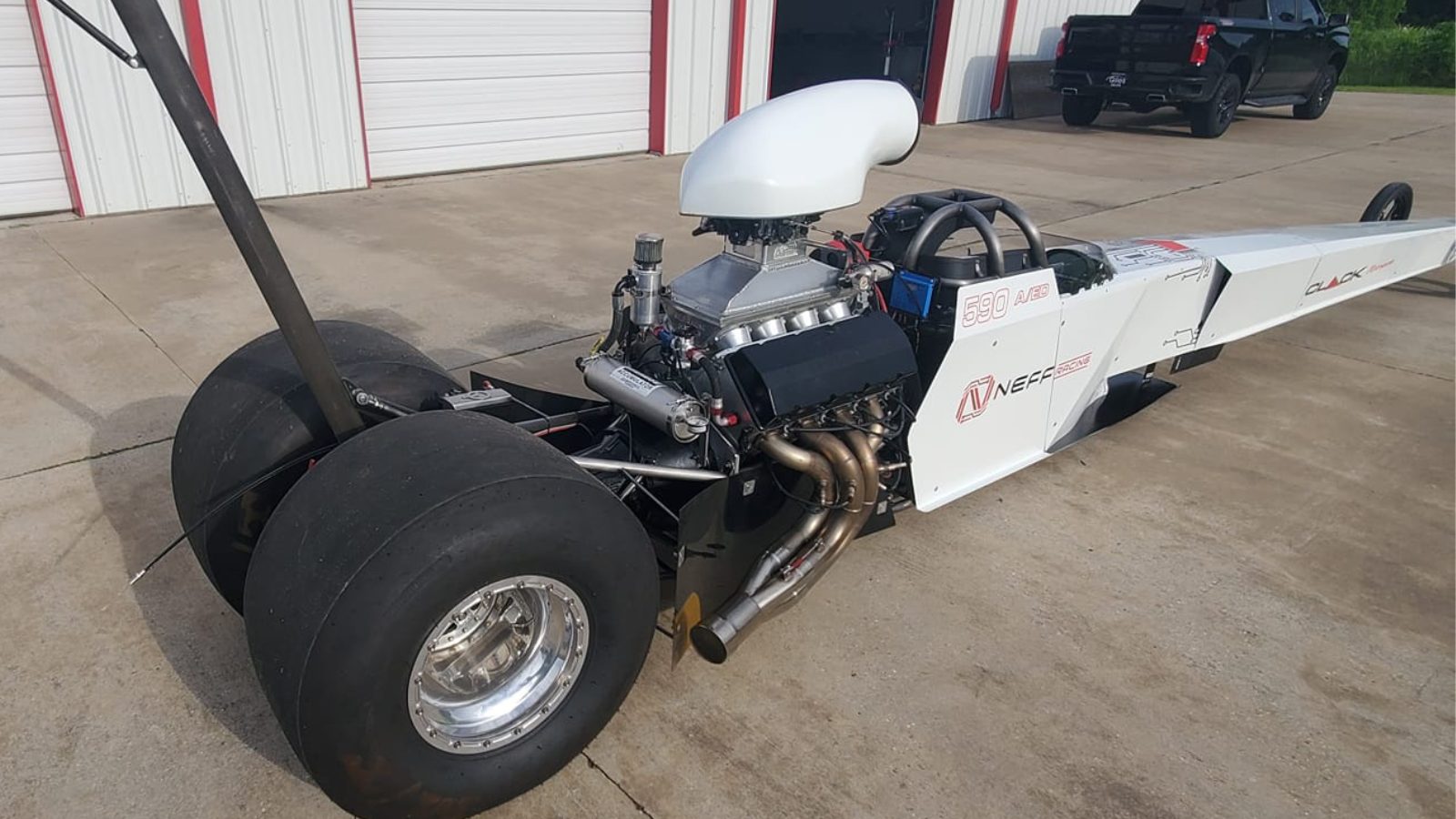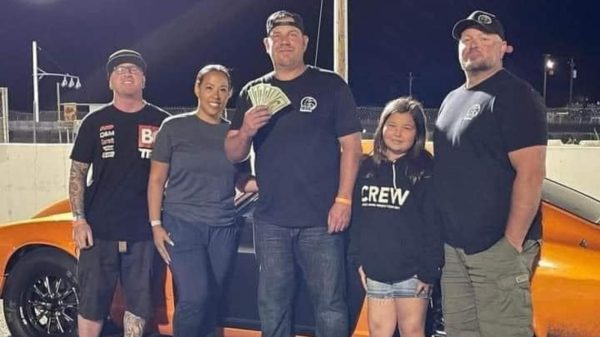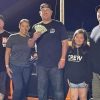When twelve-time NHRA National Event finalist Clint Neff clocked 215 mph using one four barrel carburetor, a two-speed PowerGlide transmission and a 499 cubic inch production Ford “wedge” engine with gasoline in the tank, jaws dropped at the recent NHRA Midwest Nationals. However, people were astonished not just by the performance but by every aspect of Neff’s race car and choice of powerplant if only because there is simply nothing like it anywhere else in the sport.
Within the maze of 108 classes in the NHRA’s Competition Eliminator, there are hundreds of engine, transmission, induction and fuel combinations some of which are far more competitive than others. Among that myriad of classes, however, there is an eternal battle to be the quickest and fastest in each. Clint Neff’s 215 shocker wasn’t the fastest speed ever recorded in Competition Eliminator but it was astonishingly close to unseating the fastest gas-burning, naturally aspirated dragster in history…despite not even being in the same class!
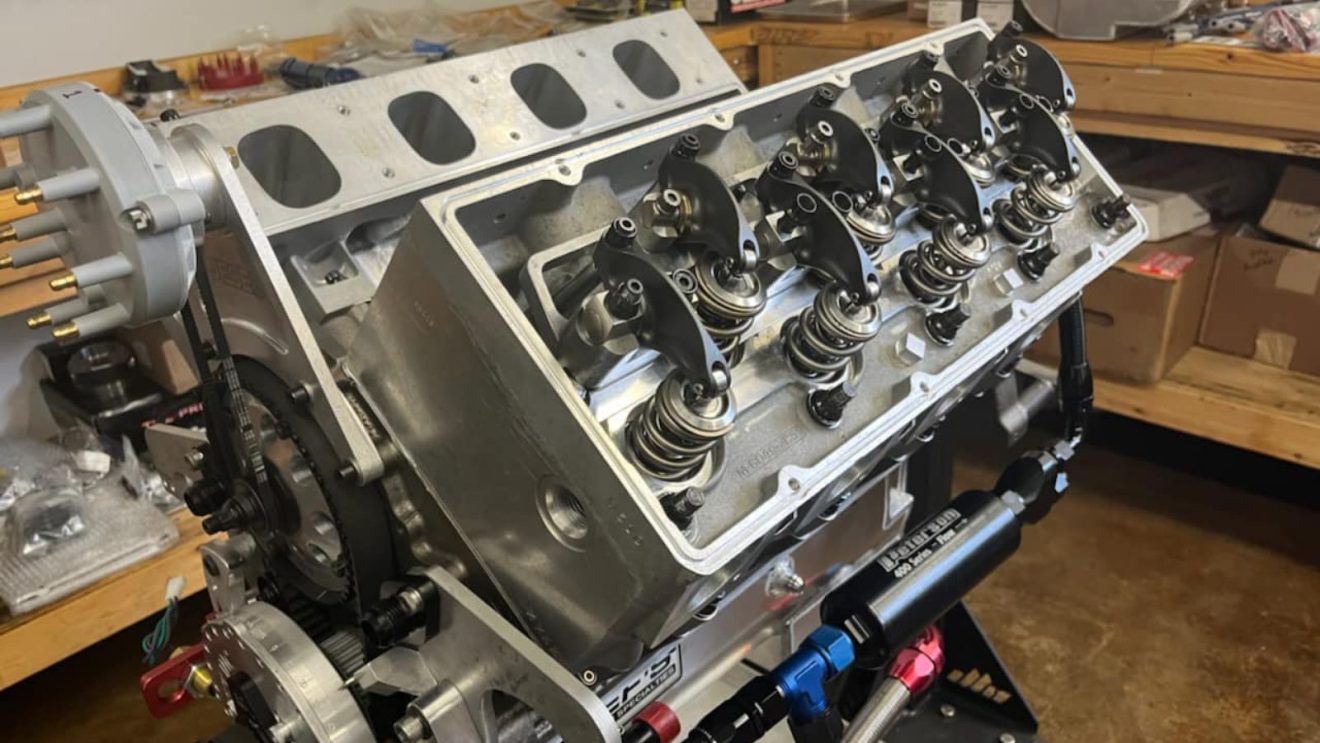
Bob Book, the owner of Book Racing Enterprises in Bonfield, Illinois, made history on Friday, March 19, 2010, when his 500 cubic inch, dual carbureted, gasoline-burning A/Dragster hit 6.42 seconds at a stunning 215.35 mph which was the fastest naturally-aspirated speed in the history of the NHRA Eliminator category simply referred to as “Comp”. Later the same day, Book’s dragster, (using what was, for all intents, an Oldsmobile Pro Stock engine), ran 6.44 at 214.72. The next day, still competing at the NHRA Cajun Sportsnationals at No Problem Raceway in Belle Rose, LA, Book shot to an astounding 6.33 at 215.62 mph to set a mark which stands to this day as the fastest A/D speed ever and, in fact, the fastest unblown gas speed clocked by anything at an NHRA event with the sole exception of a Mountain Motor Pro Stock car. Book remains the producer of many of the sport’s quickest and fastest carburetors and racing engines.
Enter Clint Neff, a second-generation racer whose father, Ron, was a Competition Eliminator standout a third of a century ago but who still attends events with his son. A native of Arvada, Colorado, Clint eventually took over his father’s I-70 & Harlan Towing Company which he runs with the third generation of the clan, Clint’s son, Brady, as well as his wife, Jamie, and daughter Cali who now also competes in Competition Eliminator in her own dragster. While the family name was connected with Chevrolet products for decades and Clint Neff scored his first NHRA National Event runner-up in a Chevy-powered C/Dragster, all five of his NHRA National Event victories and another six runner-up finishes were earned with a Ford-powered roadster competing in either the K/Altered or K/Altered Automatic classes using a four-cylinder engine.
In 2021, Neff debated returning to a V8 class but, upon discussing it with friend and chassis builder Harry Clack, Neff made the decision official. Clack, a true visionary in drag racing vehicle design and construction, had an idled project he wanted to resurrect while Neff desired to experiment with a rare and under-utilized powerplant. The duo chose the tight parameters of the NHRA’s Econo Dragster classification in which to work. Debuted by the American Hot Rod Association in 1970 as the Experimental Gas Dragster classes and promoted heavily by Car Craft Magazine the following year, the NHRA soon adopted the new designation which included cars using basically stock engines in dragster chassis. A half-century later, the rules are still exceptionally strict but there are very few aspects of a modern Econo Dragster which are economical.
Clack quickly finished work on the dragster he first designed almost a decade earlier which featured substantial influence from the Formula One aerodynamic revolution of 2002. With a highly elevated nose and driver compartment but an engine with a low center of gravity, the car looked more like the Ferrari Model F2002 which won the F1 World Championship than a dragster. From the chassis tubes to the complicated aluminum body, the car was completed entirely in Clack’s Advanced Transmission Center shop in Lafayette, LA. The powerplant was just as exotic.
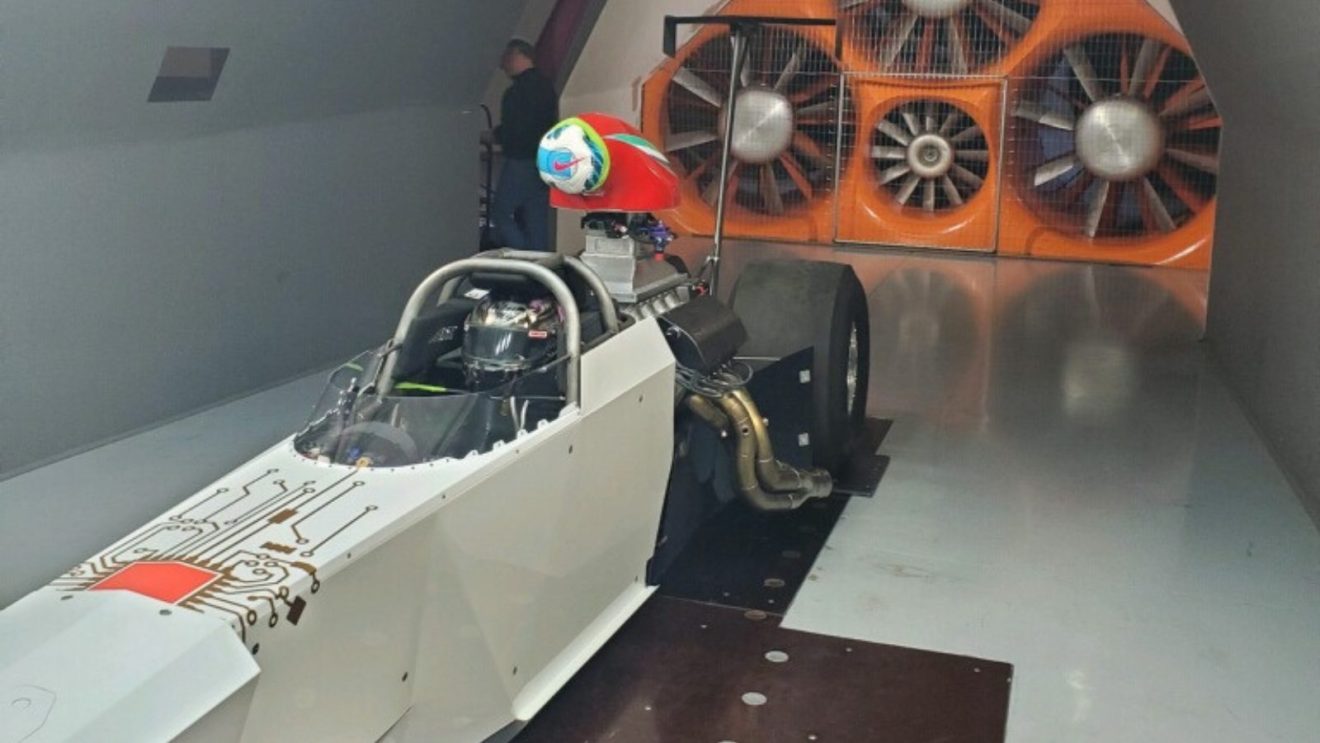
To understand the engine, induction and transmission, the rules for the class must been explained. The “A” subclassification for Econo Dragsters mandates four basic differences from conventional Gas Dragster rules. Both types of dragsters are permitted the use of one gasoline-burning V8 engine but the Econo version is restricted to one four-barrel carburetor, a production automatic transmission with a maximum of three forward speeds, and a powerplant with a production engine block and production cylinder heads, both of which require visible production part numbers and the corporate logo in the casting. The car must weigh at least 3.40 pounds for every cubic inch of engine displacement with a minimum of 1,350 pounds with driver.
General Motors engines have dominated the A/ED class. While the late, great John Lingenfelter recorded the first six-second run for a carbureted gas-burning dragster in NHRA competition when he drove his Oldsmobile-powered A/Dragster to a 6.962-second run at the 1986 NHRA U.S. Nationals, he switched to the A/ED class in 1991 with a similar powerplant and recorded the first six-second run in the Econo ranks, as well. For the past two decades, the undisputed king of the A/ED class has been another Indiana veteran, Robert Bailey, whose Chevy-powered dragster has been in the 6.5-second zone since 2007. Clint Neff had a completely different plan of attack.
Unknown to many people, Clint Neff was racing his successful K/AA roadster four-cylinder roadster using parts of one of the least known factory performance packages in recent drag racing history. Within the engine in his altered was a story with an incredibly clandestine history of which only a handful of racers were aware.
Like the rules for A/Econo Dragster, the NHRA regulations for Pro Stock Eliminator mandate the use of a factory-produced, publically available engine block and cylinder heads which display a factory part number and the corporate logo. For the past fifteen years, ninety percent of all NHRA Pro Stock entries have utilized the General Motors Drag Racing Competition Engine which is now in its third iteration. The GM DRCE 3 engine block, (part number 25534406), and the corresponding DRCE 3 cylinder heads, (part number 25534404), are available directly from GM Performance and were specifically designed for NHRA 500 cubic inch Pro Stock competition. The DRCE program was initiated in 1982 as an Oldsmobile engineering project with Warren Johnson as the chief designer and, eventually, the top beneficiary. However, the development languished until Warren Johnson took over the program in 1983 and finished it on his own. The original DRCE was redesigned in 1992 to reflect more of a Chevrolet design than its original Oldsmobile configuration. After the DRCE 2 debuted, another legendary designer became involved.
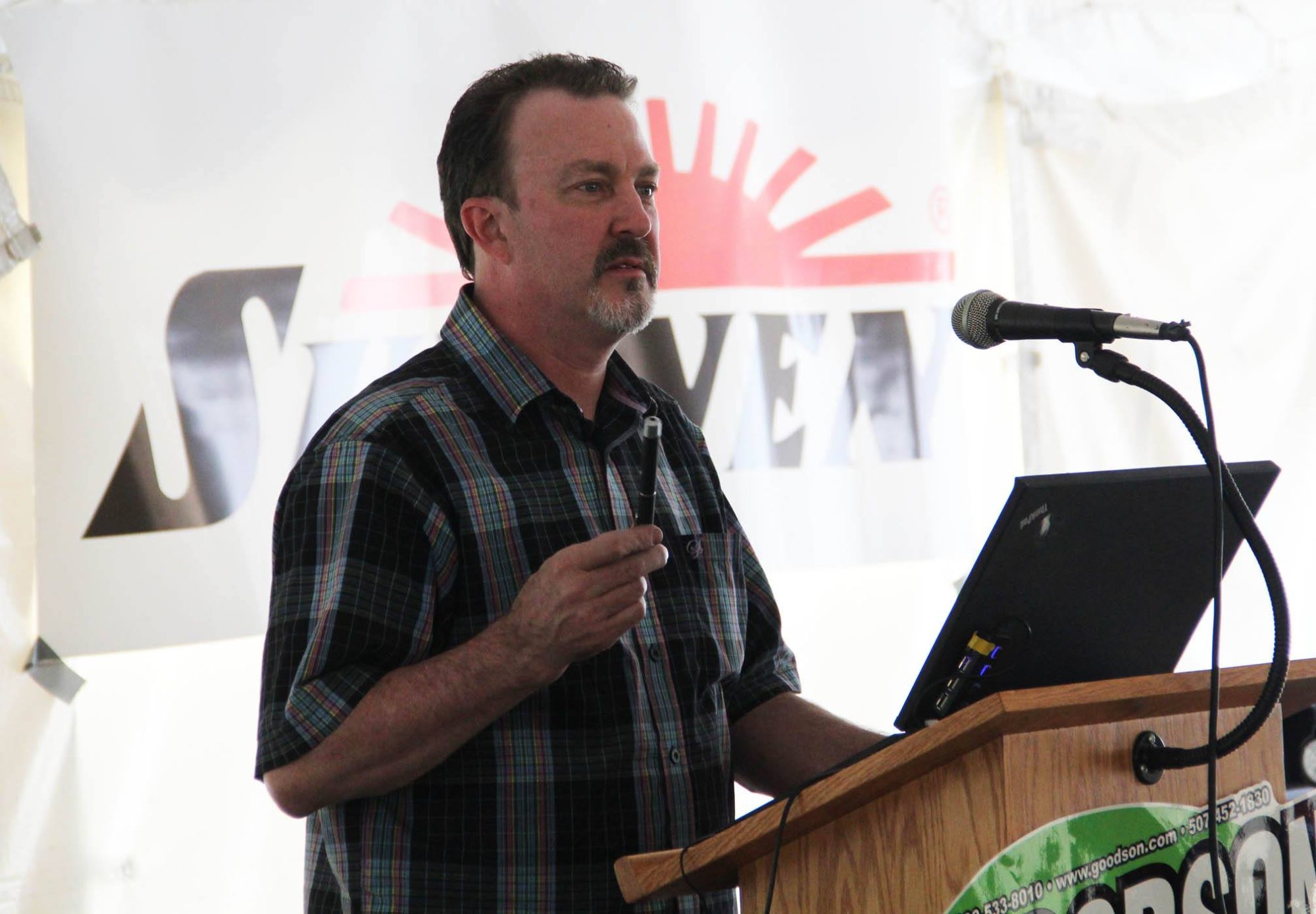
Darin Morgan at a speaking engagement in 2015
Darin Morgan has long been lauded as one of the most influential cylinder head designers and constructors in drag racing. He has worked side-by-side with the biggest names in the sport’s engine building annals including Warren Johnson, Bob Glidden and more than two decades with David Reher and Buddy Morrison. Now working with Tony Bischoff’s BES Racing Engines in Guilford, IN, Morgan was involved in nearly every facet of Pro Stock’s rapidly evolving technology.
In light of the success of the DRCE program, the Ford Motor Company began distancing itself from NHRA Pro Stock competition and FoMoCo’s superstar, Bob Glidden, finally sold his last factory-backed Ford Pro Stocker, (his 1996 Ford SVO Probe), and his entire inventory of parts to Eli Patrick in 1997. This left a miniscule group of Ford Pro Stock racers, (which never numbered more than four teams in a season), to carry on against the ever-improving engineering of the General Motors-motivated majority. That small group consisted mostly of the Patrick family, Vermont’s Hurley Blakeney, Washington’s Mark Wolfe and one longtime east coast Ford fan.
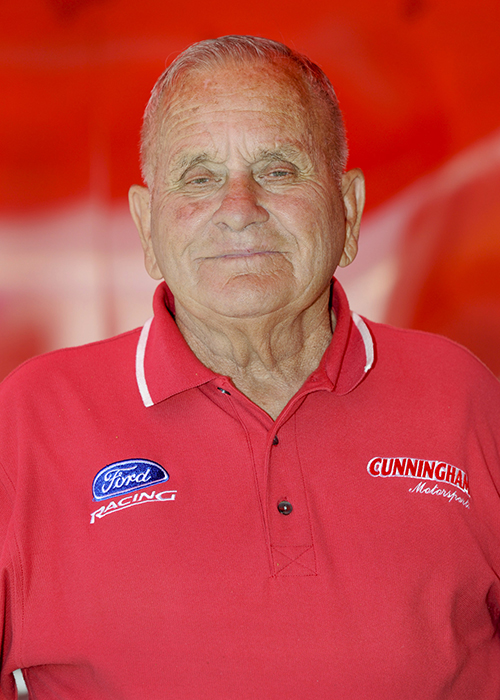
Jim Cunningham, who became the oldest driver to ever make an NHRA Pro Stock field at 73, passed away Aug. 19 in Annapolis, MD, at the age of 77.
That “fan” was a Ford diehard named Jim Cunningham. Based in Maryland, he was a hardcore “blue oval” racer who stepped into NHRA Pro Stock as early as 1991 but, as owner/operator of Capitol Raceway in his home state, (and the massive quarry which borders the track property), he rarely ventured far from the eastern seaboard. By 2000, however, Cunningham got serious about NHRA Pro Stock and sold his inventory of IHRA Pro Stock “mountain motors” and concentrated on 500-inch racing with a new 2000 Mercury Cougar, (rumored to be the first Pro Stocker with a carbon fiber body), built by Jerry Haas Race Cars.
Cunningham struggled with a variety of Ford engine programs but finally put respected crew chief Tom Sweeney in the position of developing a new engine program. Cunningham also realized he needed the best person in the driver’s seat to stand a chance. Although Jim drove in at least a few races each year, he put Haas behind the wheel in an attempt to simultaneously tune the chassis and the powertrain. With Haas not always available, Cunningham began recruiting an amazing line up of pilots to drive his line of Cougars, Ford Escorts and, eventually, the first of the new generation of S197 Ford Mustangs. From 2000 through 2014, racers found in the cockpit of Cunningham’s Fords included Haas, local upstart Josh King, a young Texas star named Erica Enders, Coloradoan Danny Gruinger, Virginia’s Buddy Perkinson, standout South Carolina female Grace Howell, Lewis Worden of Missouri and, in his last racing appearances in 2010, even Cunningham’s personal idol, Bob Glidden.
The majority of Cunningham’s machines were powered by the Glidden-designed Boss 429-based “shotgun” Hemi-headed Ford engine which was, in fact, obsolete by a decade. Although Glidden was working on a “wedge” engine for NHRA racing, it never proved its feasibility before he sold his operation. Cunningham, firmly believing there was still value in Ford factory engineering, finally petitioned the Ford Motor Company in 2007 to restart its Research & Development programs for Pro Stock engines. Ford responded with a simple caveat. If Cunningham would pay for it, they’d build anything he wanted. Incredibly, Cunningham agreed to fund the entire process.
The first person Ford Motor Company called to lead the project was none other than Darin Morgan, who was given free rein on the configuration of the cylinder heads and the engine block. Morgan took the opportunity as a blessing. In a candid comment to DI, Morgan stated, “When Warren (Johnson) and I were working together on the DRCE 2, we spent most of our time on the phone with each other discussing all the shortcomings of the DRCE heads, valvetrain and block. I decided very quickly the new Ford heads and block would have none of those problems”.
Initially, Ford planned a run of twenty sets of heads and twenty blocks. However, the first order was cut to six sets of heads and six blocks. Meanwhile, the R&D was expanded so that the very first casting run at Pro Stock engine builder Ray Franks’ Ohio-based Pro-filer Performance Products foundry, (later of aerospace leader High Tech Castings, Inc.), included three “wedge” head engines, considered 429-460 Ford packages, and two Hemi head engines with which to continue the Boss 429 configuration. Using the wedge engines, (which are, in fact, considered a “splayed valve” configuration by the NHRA), Cunningham immediately began a strenuous testing regimen and, at the 2010 NHRA Northwest Nationals at Pacific Raceways near Seattle, WA, Cunningham became, at age 73, the oldest qualifier in NHRA Pro Stock history.
Over the next four years, Cunningham’s Mustangs with the “JC51” engines were competitive. In 2012, Grace Howell ran 6.55 at 210.67 at the NHRA Four-Wide Nationals at Concord, NC, where Low ET of the Meet was a 6.49. Worden actually got the car to run 210.83 mph at the 2014 NHRA Gatornationals at Gainesville, FL. Unfortunately, Cunningham’s health began to fail and he succumbed to lung cancer on August 19, 2014, at age 77 ending both his racing and his legacy. Haas and Sweeney were at Jim’s side when he passed.

Enter Clint Neff, one of the few racers aware the “JC51” equipment was still in the Ford Performance Parts catalog. Cunningham’s own equipment was still being used on Neff K/AA roadster but, as a four-cylinder racer, Neff was only using ONE JC51 cylinder head. More than almost anybody, Neff understood the potential of the parts which were becoming exceedingly rare and spent much time gathering up what he could find.
He quickly found out the Hemi-head JC51 engines had disappeared but Clint was able to amass a total of 156 head gaskets from Larry Morgan who was also involved in the original project. At that point, Neff began assembling an operating JC51 block and heads for duty in A/ED since, in fact, the equipment can still be purchased from Ford. Neff didn’t need to order any new pieces, noting Ford doesn’t keep the blocks and heads on their shelves. However, if somebody orders the parts, Ford will cast them.
While Harry Clack finished the radical chassis, Neff had the engine assembled by the best in the business. The rules specify an “OEM (Original Equipment Manufacturer) four-barrel carburetor” so Neff went to the man with the fastest gas dragster on the planet, Bob Book, to get a Book Racing Enterprises Model 250 carb which flows over 1500 cubic feet of air per minute. For the intake manifold, Neff turned to one of his closest friends and one of the best ever to design a plenum, the late Kevin Self who passed away on November 11, 2021, not long after completing the project which would be his last manifold. The intake runners were supplied by Williams Engineering of Ohio and, in Self’s stead, the manifold was finished up by JC51 designer Darin Morgan who has been a constant source of support for Neff.
The Neff JC51 engine now includes Victory 1 Performance valves, PAC Racing valve springs, a camshaft from Comp Cams and Gibtec pistons on GRP connecting rods, (both Colorado companies), mated to a Bryant Racing crankshaft. Liquids are handled by an oil pump from Peterson Fluid Systems with a MagnaFuel fuel pump and regulator, (two more Colorado firms). The exhausts were formed by Wes Collins’ Pro Header Systems. The entire package was assembled and balanced by NHRA National Event-winning Competition Eliminator racer Don Thomas at his Panhandle Performance Engines shop in Amarillo, TX. The JC51 is hooked up to Coan Engineering two-speed General Motors PowerGlide transmission. It should be noted the NHRA Econo Dragster rules forbid any form of “lock-up” torque converter.
Meanwhile, Clack finished up the chassis in Louisiana adding a 12-inch Strange Engineering rear end, (equipped with Strange axles and U.S. Gears), to lower the engine in the chassis. The car was then outfitted with Mickey Thompson 32 X14 slicks and Goodyear Top Fuel dragster front tires all on wheels from Lindsey Racing Products. Clack finished the complex body panels and the aerodynamics under and around the driver’s compartment. Permitted under the A/ED rules to weigh as little as 1,596 pounds with the driver in it, the finished car reached that goal.
When the engine was completed, it went straight into Clack’s outrageous chassis and headed for Mooresville, NC, to be mounted in the Air 2 Wind Tunnel used by most U.S. motorsports teams. There, the duo learned Clack’s theories were sound and found the car responded best to an unusual Delta shaped rear wing which offers less resistance and more downforce.
The car was tested at Xtreme Raceway Park in Ferris, TX, with no serious problems and the car’s debut and the 2022 NHRA U.S. Nationals at Indianapolis, IN, produced a disappointing 6.85-second, 158 mph shut off which was the car’s only full run in qualifying. A 6.75 at 194.77 mph lost in the opening round, (ironically, to Raymond Martin’s K/AA four-cylinder), but was unimpressive in light of Robert Bailey’s best of 6.62/205.10 in A/Econo Dragster at the same event.
That’s why jaws dropped three weeks later on Friday, September 30, 2022, at World Wide Technology Raceway in Madison, IL, when Clint Neff launched from the starting line with a 1.023-second sixty feet elapsed time, a 4.22/168.56 eighth-mile and a simply indescribable 6.545-second quarter-mile at a nearly unbelievable 215.34 miles per hour. The run was not only the quickest in class history by a hundredth of a second but eclipsed any previous speed for an A/ED by over six miles per hour. In fact, the ET was quicker than all but fourteen previous unblown gas dragsters in Competition Eliminator’s nearly sixty-year history. The speed was only bettered by Bob Book’s 215.62 in A/D a dozen years earlier. Neff’s 46.78 mph “backhalf” from the eighth-mile to the quarter-mile, was beyond comprehension. The historic pass also qualified Neff & Clack number one in Comp.

Only two pairs after Neff’s run, Bailey’s Agan-chassised Chevy-powered A/ED made a run with even quicker progressive times that Neff, including a staggering 1.010 “sixty” and a 4.20/168.62 “eighth”, which resulted in a career-best 6.550 at 203.95 mph and a more realistic 35.33 mph “backhalf”. On the surface, there was no accounting for the thirteen mph difference in top speed. Was it the aerodynamic advances in the chassis? Was it the engine combination? Was it both? was it the fact Neff was shifting at 10,000 RPM and the engine was turning the same speed at the finish line?
Closer inspection showed Neff’s machine ran 0.025 seconds quicker through the final 320 feet of the track which, when that final distance is used as a separate speed trap, shows Neff traveling 205.63 mph to Bailey’s 200.90.
With all eyes now on Neff’s new ride, the second qualifying run later the same day produced a slightly slower 6.61 but the speed was another spectacular 211.69 mph. Bailey, in turn, clocked a stunningly consistent 6.553 at 206.48. While Bailey covered both the 660-1000 and 1000-1320 distances quicker, (1.265 to 1.278 seconds and 1.085 to 1.086 seconds, respectively), the staggering news on the second passes was Bailey improved to a 38.24 mph “backhalf” while Neff gained an incredible 50.12 mph in the last eighth-mile!
 The following day, both drivers suffered problems in the third and final qualifying session although Bailey did record an amazing 1.003 “sixty”. On race day, the many onlookers of this A/ED Clash Of The Titans were left with unanswered questions. Neff had problems and rolled the starting line beams for a first round loss while Bailey advanced to the third round despite never making a full pass or running better than a 1.02-second sixty-feet ET.
The following day, both drivers suffered problems in the third and final qualifying session although Bailey did record an amazing 1.003 “sixty”. On race day, the many onlookers of this A/ED Clash Of The Titans were left with unanswered questions. Neff had problems and rolled the starting line beams for a first round loss while Bailey advanced to the third round despite never making a full pass or running better than a 1.02-second sixty-feet ET.
As with any record-setting outing which smashes previous records by huge margins, there are nonbelievers. Only future performance can determine the viability of any race car, much less one which bucks nearly every convention in its class. Unlike over seven hundred of his fellow racers, Neff made the decision to head back to Arvada, CO, to run the family business rather than stay at WWT Raceway for a four-day NHRA LODRS Regional/Divisional “double spectacular” held in stunning weather conditions.
The next time Neff and Clack hit the track will be this weekend at the NHRA Texas Fall Nationals at the Texas Motorplex near Dallas. Although atmospheric conditions may be warmer, the all-concrete track is a known record crusher in its own right. Again, all eyes will be on the new Neff-Clack machine to see if it can back up the numbers posted in Madison.
“We’re not concerned about numbers at Dallas”, Neff told DI. “We just want to win. That’s what this is all about”. While it may be the fastest of its type, the car has yet to win a round in the ultra-complicated world of Competition Eliminator.
Meanwhile, the drag racing world can watch a rare attempt at shattering simple performance barriers in Competition Eliminator, courtesy of a single four barrel carbureted, gas-burning, production bigblock Ford with a two-speed automatic transmission in a chassis few could have even dreamed of constructing. Clint Neff and Harry Clack are supplying the thrills with what is currently the most unique car in the business using an engine most humans never even knew existed.
Sit back and enjoy their ride!
This story was originally published on October 12, 2022. 


